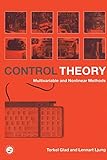Control theory : multivariable and nonlinear methods / Torkel Glad and Lennart Ljung.
Material type: TextLanguage: English Original language: Swedish Publication details: London ; New York : Taylor & Francis, 2000.Description: 1 online resource (xiv, 467 pages) : illustrationsContent type:
TextLanguage: English Original language: Swedish Publication details: London ; New York : Taylor & Francis, 2000.Description: 1 online resource (xiv, 467 pages) : illustrationsContent type: - text
- computer
- online resource
- 9781315274737 (electronic bk.)
- 1315274736 (electronic bk.)
- Reglerteori. English
- 629.8/312 21
- QA402.3 .G55413 2000
- SK 880
- ZQ 5200
Includes bibliographical references and index.
1.1 Multivariable Systems 2 -- 1.2 Nonlinear Systems 5 -- 1.3 Discrete and Continuous Time Models and Controllers 6 -- 1.4 Some Basic Concepts in Control 8 -- 1.5 Gain and Signal Size 15 -- 1.6 Stability and the Small Gain Theorem 18 -- Part I Linear Systems 25 -- 2 Representation of Linear Systems 27 -- 2.1 Impulse Response and Weighting Function 27 -- 2.2 Transfer Function Matrices 28 -- 2.3 Transfer Operator 30 -- 2.4 Input--Output Equations 30 -- 2.5 State Space Form 31 -- 2.6 Discrete Time Systems 37 -- 3 Properties of Linear Systems 43 -- 3.1 Solving the System Equations 43 -- 3.2 Controllability and Observability 44 -- 3.3 Poles and Zeros 48 -- 3.4 Stability 53 -- 3.5 Frequency Response and Frequency Functions 58 -- 3.6 Model Reduction 63 -- 3.7 Discrete Time Systems 68 -- 3A Proofs 79 -- 4 Sampled Data Systems 83 -- 4.1 Approximating Continuous Time Systems 83 -- 4.2 System Sampling 85 -- 4.3 Poles and Zeros 90 -- 4.4 Controllability and Observability 93 -- 4.5 Frequency Functions 96 -- 5 Disturbance Models 101 -- 5.1 Disturbances 101 -- 5.2 Signal Size and Scaling 103 -- 5.3 Spectral Description of Disturbances 106 -- 5.4 Description of Disturbances in the Time Domain 112 -- 5.5 Estimation of One Signal from Another 114 -- 5.6 Measurement and System Disturbances 116 -- 5.7 Observers and Kalman Filters 124 -- 5.8 Discrete Time Systems 131 -- 5.9 Practical Aspects of Signal Sampling 139 -- 5A Proofs 141 -- Part II Linear Control Theory 145 -- 6 Closed Loop System 147 -- 6.1 Transfer Functions of the Closed Loop System 147 -- 6.2 Stability of the Closed System 150 -- 6.3 Sensitivity and Robustness 152 -- 6.4 Specifications 155 -- 6.5 Specifications in the Time Domain 156 -- 6.6 Specifications in the Frequency Domain 159 -- 6.7 Sampled Data Controllers 164 -- 7 Basic Limitations in Control Design 171 -- 7.1 Scaling of Variables 171 -- 7.2 Intuitive Analysis 172 -- 7.3 Loop Gain Limitations 176 -- 7.4 S and T: Individual Limitations 179 -- 7.5 Consequences for the System Performance 186 -- 7.6 Effects of Control Signal Bounds 192 -- 7.7 Multivariable Case 195 -- 7.8 Some Examples 201 -- 7A Proofs 209 -- 8 Controller Structures and Control Design 215 -- 8.1 Main Ideas 216 -- 8.2 Configuration of Multivariable Controllers 219 -- 8.3 Internal Model Control 228 -- 8.4 Feedback from Reconstructed States 233 -- 9 Minimization of Quadratic Criteria: LQG 239 -- 9.1 Criterion and the Main Ideas 239 -- 9.2 Optimal Controller: Main Results 242 -- 9.3 Some Practical Aspects 247 -- 9.4 Robustness for LQG Controllers 257 -- 9.5 Discrete Time Systems 264 -- 9A Proofs 273 -- 10 Loop Shaping 277 -- 10.1 Direct Methods 277 -- 10.2 Formalization of the Requirements 278 -- 10.3 Optimal H[subscript 2] Control 284 -- 10.4 Optimal H[subscript infinity] Control 285 -- 10.5 Robust Loop Shaping 293 -- 10.6 Discrete Time Systems 300 -- 10A To Decrease the Spread of the Singular Values 303 -- Part III Nonlinear Control Theory 305 -- 11 Describing Nonlinear Systems 307 -- 11.1 Linear Versus Nonlinear 308 -- 11.2 Examples of Nonlinear Systems 312 -- 11.3 Mathematical Description 314 -- 11.4 Equilibria and Linearization 317 -- 12 Stability of Nonlinear Systems 321 -- 12.1 Stability of Equilibria 321 -- 12.2 Stability and Lyapunov Functions 323 -- 12.3 Circle Criterion 329 -- 12A Proofs 337 -- 13 Phase Plane Analysis 339 -- 13.1 Phase Planes for Linear Systems 339 -- 13.2 Phase Planes for Nonlinear Systems 346 -- 14 Oscillations and Describing Functions 355 -- 14.1 Describing Function Method 356 -- 14.2 Computing Amplitude and Frequency of Oscillations 360 -- 14A Some Describing Functions 366 -- 15 Controller Synthesis for Nonlinear Systems 371 -- 15.1 Linearg Design and Nonlinear Verification 371 -- 15.2 Nonlinear Internal Model Control 372 -- 15.3 Parametric Optimization 374 -- 15.4 Other Approaches 377 -- 15.5 State Feedback and Observer 378 -- 16 Model Predictive Control 383 -- 16.1 Basic Idea: Predict the Output 383 -- 16.2 [kappa]-step Prediction for Linear Systems 384 -- 16.3 Criterion and the Controller 385 -- 17 To Compensate Exactly for Nonlinearities 393 -- 17.1 Examples of Exact Linearization 393 -- 17.2 Relative Degree 395 -- 17.3 Input-Output Linearization 397 -- 17.4 Exact State Linearization 401 -- 18 Optimal Control 407 -- 18.1 Goddard Rocket Problem 407 -- 18.2 Maximum Principle 410 -- 18.3 Solution of the Goddard Rocket Problem 424 -- 18.4 Minimum Time Problems 428 -- 18.5 Optimal Feedback 436 -- 18.6 Numerical Methods 442 -- 18A Proof of the Maximum Principle 445.
Electronic reproduction. London Available via World Wide Web.
Translated from the Swedish.
Description based on print version record.
